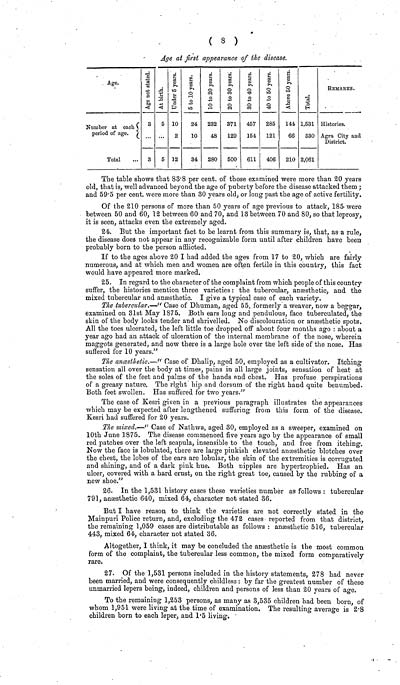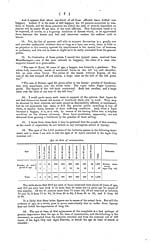Download files
Individual page:
Thumbnail gallery: Grid view | List view

( 8 )
Age at first appearance of the disease.
Age.
Age not stated.
At birth.
Under 5 years.
5 to 10 years.
10 to 20 years.
20 to 30 years.
30 to 40 years.
40 to 50 years.
Above 50 years.
Total
REMARKS.
Number at each
3
5
10
24
232
371
457
285
144
1,531
Histories.
period of age.
...
2
10
48
129
154
121
66
530
Agra City and District.
Total
3
5
12
34
280
500
611
406
210
2,061
The table shows that 838 per cent. of those examined were more than 20 years
old, that is, well advanced beyond the age of puberty before the disease attacked them ;
and 595 per cent, were more than 30 years old, or long past the age of active fertility.
Of the 210 persons of more than 50 years of age previous to attack, 185 were
between 50 and 60, 12 between 60 and 70, and 13 between 70 and 80, so that leprosy,
it is seen, attacks even the extremely aged.
24. But the important fact to be learnt from this summary is, that, as a rule,
the disease does not appear in any recognizable form until after children have been
probably born to the person afflicted.
If to the ages above 20 I had added the ages from 17 to 20, which are fairly
numerous, and at which men and women are often fertile in this country, this fact
would have appeared more marked.
25. In regard to the character of the complaint from which people of this country
suffer, the histories mention three varieties: the tubercular, ansthetic, and the
mixed tubercular and ansthetic. I give a typical case of each variety.
The tubercular.-" Case of Dhuman, aged 55, formerly a weaver, now a beggar,
examined on 31st May 1875. Both ears long and pendulous, face tuberculated, the
skin of the body looks tender and shrivelled. No discolouration or ansthetic spots.
All the toes ulcerated, the left little toe dropped off about four months ago : about a
year ago had an attack of ulceration of the internal membrane of the nose, wherein
maggots generated, and now there is a large hole over the left side of the nose. Has
suffered for 10 years."
The ansthetic.-" Case of Dhalip, aged 50, employed as a cultivator. Itching
sensation all over the body at times, pains in all large joints, sensation of heat at
the soles of the feet and palms of the hands and chest. Has profuse perspirations
of a greasy nature. The right hip and dorsum of the right hand quite benumbed.
Both feet swollen. Has suffered for two years."
The case of Kesri given in a previous paragraph illustrates the appearances
which may be expected after lengthened suffering from this form of the disease.
Kesri had suffered for 20 years.
The mixed.-"Case of Nathwa, aged 30, employed as a sweeper, examined on
10th June 1875. The disease commenced five years ago by the appearance of small
red patches over the left scapula, insensible to the touch, and free from itching.
Now the face is lobulated there are large pinkish elevated ansthetic blotches over
the chest, the lobes of the ears are lobular, the skin of the extremities is corrugated
and shining, and of a dark pink hue. Both nipples are hypertrophied. Has an
ulcer, covered with a hard crust, on the right great toe, caused by the rubbing of a
new shoe."
26. In the 1,531 history cases these varieties number as follows : tubercular
791, ansthetic 640, mixed 64, character not stated 36.
But I have reason to think the varieties are not correctly stated in the
Mainpuri Police return, and, excluding the 472 cases reported from that district,
the remaining 1,059 cases are distributable as follows : ansthetic 516, tubercular
443, mixed 64, character not stated 36.
Altogether, I think, it may be concluded the ansthetic is the most common
form of the complaint, the tubercular less common, the mixed form comparatively
rare.
27. Of the 1,531 persons included in the history statements, 278 had never
been married, and were consequently childless: by far the greatest number of these
unmarried lepers being, indeed, children and persons of less than 20 years of age.
To the remaining 1,253 persons, as many as 3,535 children had been born, of
whom 1,951 were living at the time of examination. The resulting average is 2.8
children born to each leper, and 1.5 living.
Age at first appearance of the disease.
Age.
Age not stated.
At birth.
Under 5 years.
5 to 10 years.
10 to 20 years.
20 to 30 years.
30 to 40 years.
40 to 50 years.
Above 50 years.
Total
REMARKS.
Number at each
3
5
10
24
232
371
457
285
144
1,531
Histories.
period of age.
...
2
10
48
129
154
121
66
530
Agra City and District.
Total
3
5
12
34
280
500
611
406
210
2,061
The table shows that 838 per cent. of those examined were more than 20 years
old, that is, well advanced beyond the age of puberty before the disease attacked them ;
and 595 per cent, were more than 30 years old, or long past the age of active fertility.
Of the 210 persons of more than 50 years of age previous to attack, 185 were
between 50 and 60, 12 between 60 and 70, and 13 between 70 and 80, so that leprosy,
it is seen, attacks even the extremely aged.
24. But the important fact to be learnt from this summary is, that, as a rule,
the disease does not appear in any recognizable form until after children have been
probably born to the person afflicted.
If to the ages above 20 I had added the ages from 17 to 20, which are fairly
numerous, and at which men and women are often fertile in this country, this fact
would have appeared more marked.
25. In regard to the character of the complaint from which people of this country
suffer, the histories mention three varieties: the tubercular, ansthetic, and the
mixed tubercular and ansthetic. I give a typical case of each variety.
The tubercular.-" Case of Dhuman, aged 55, formerly a weaver, now a beggar,
examined on 31st May 1875. Both ears long and pendulous, face tuberculated, the
skin of the body looks tender and shrivelled. No discolouration or ansthetic spots.
All the toes ulcerated, the left little toe dropped off about four months ago : about a
year ago had an attack of ulceration of the internal membrane of the nose, wherein
maggots generated, and now there is a large hole over the left side of the nose. Has
suffered for 10 years."
The ansthetic.-" Case of Dhalip, aged 50, employed as a cultivator. Itching
sensation all over the body at times, pains in all large joints, sensation of heat at
the soles of the feet and palms of the hands and chest. Has profuse perspirations
of a greasy nature. The right hip and dorsum of the right hand quite benumbed.
Both feet swollen. Has suffered for two years."
The case of Kesri given in a previous paragraph illustrates the appearances
which may be expected after lengthened suffering from this form of the disease.
Kesri had suffered for 20 years.
The mixed.-"Case of Nathwa, aged 30, employed as a sweeper, examined on
10th June 1875. The disease commenced five years ago by the appearance of small
red patches over the left scapula, insensible to the touch, and free from itching.
Now the face is lobulated there are large pinkish elevated ansthetic blotches over
the chest, the lobes of the ears are lobular, the skin of the extremities is corrugated
and shining, and of a dark pink hue. Both nipples are hypertrophied. Has an
ulcer, covered with a hard crust, on the right great toe, caused by the rubbing of a
new shoe."
26. In the 1,531 history cases these varieties number as follows : tubercular
791, ansthetic 640, mixed 64, character not stated 36.
But I have reason to think the varieties are not correctly stated in the
Mainpuri Police return, and, excluding the 472 cases reported from that district,
the remaining 1,059 cases are distributable as follows : ansthetic 516, tubercular
443, mixed 64, character not stated 36.
Altogether, I think, it may be concluded the ansthetic is the most common
form of the complaint, the tubercular less common, the mixed form comparatively
rare.
27. Of the 1,531 persons included in the history statements, 278 had never
been married, and were consequently childless: by far the greatest number of these
unmarried lepers being, indeed, children and persons of less than 20 years of age.
To the remaining 1,253 persons, as many as 3,535 children had been born, of
whom 1,951 were living at the time of examination. The resulting average is 2.8
children born to each leper, and 1.5 living.
Set display mode to: Large image | Zoom image | Transcription
Images and transcriptions on this page, including medium image downloads, may be used under the Creative Commons Attribution 4.0 International Licence unless otherwise stated. ![]()
| India Papers > Medicine - Disease > Distribution and causation of leprosy in British India 1875 > (21) Page 8 |
|---|
| Permanent URL | https://digital.nls.uk/74506342 |
|---|---|




